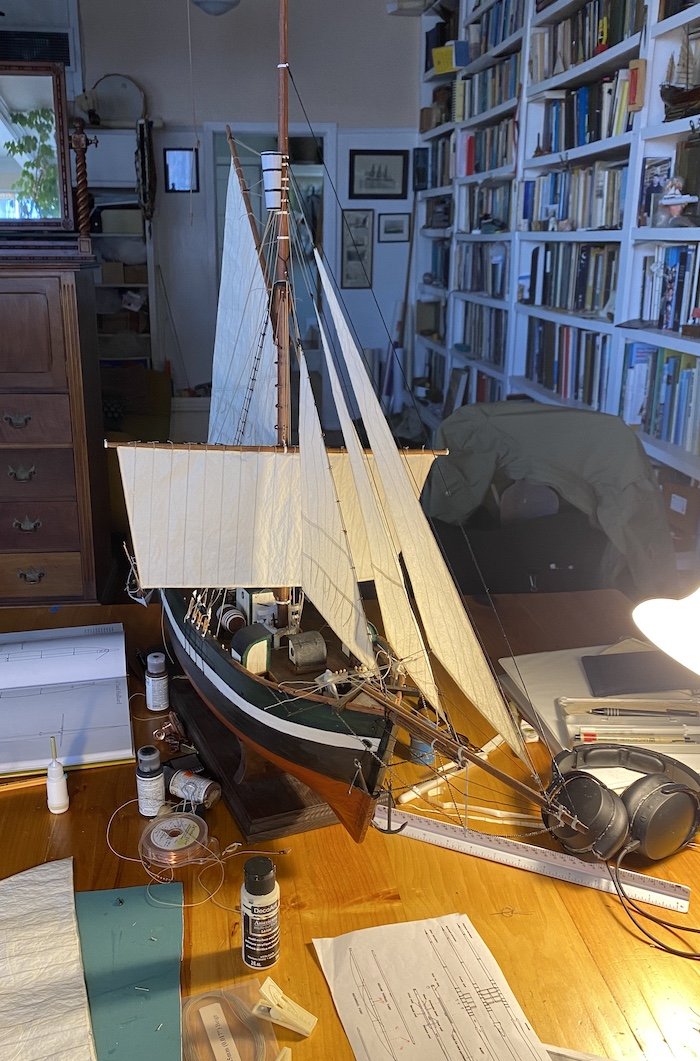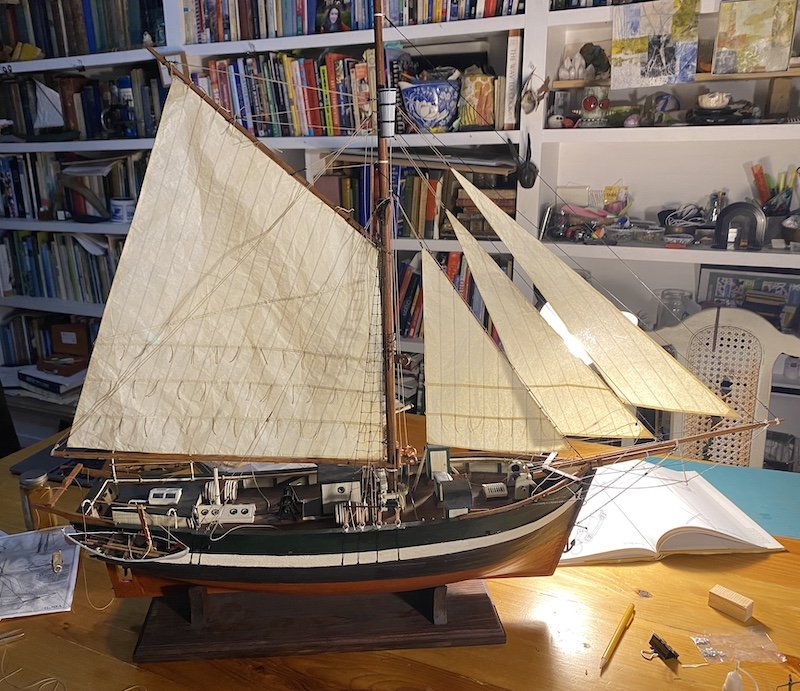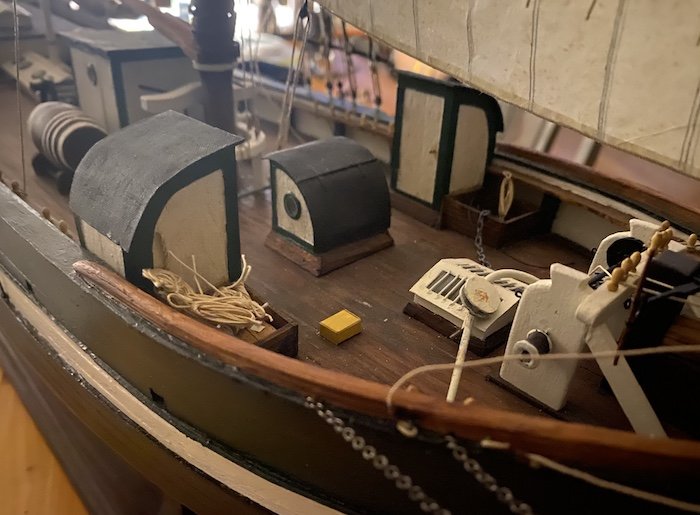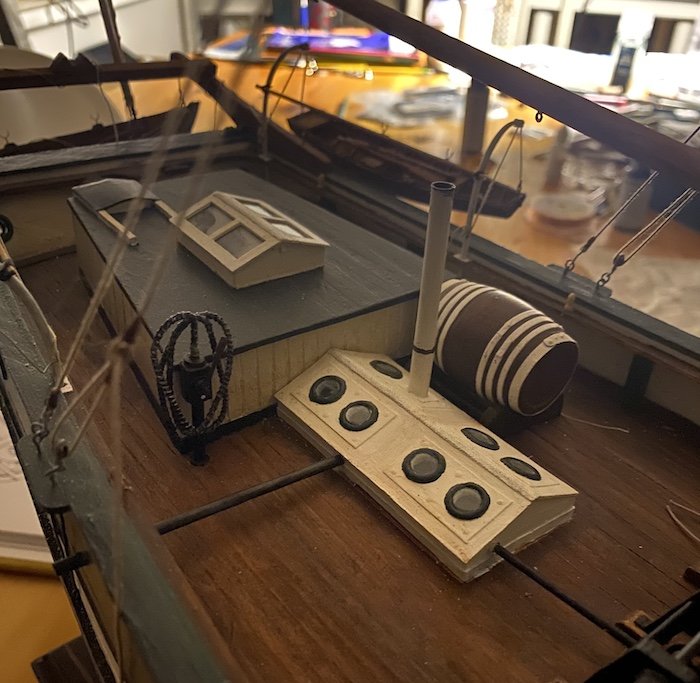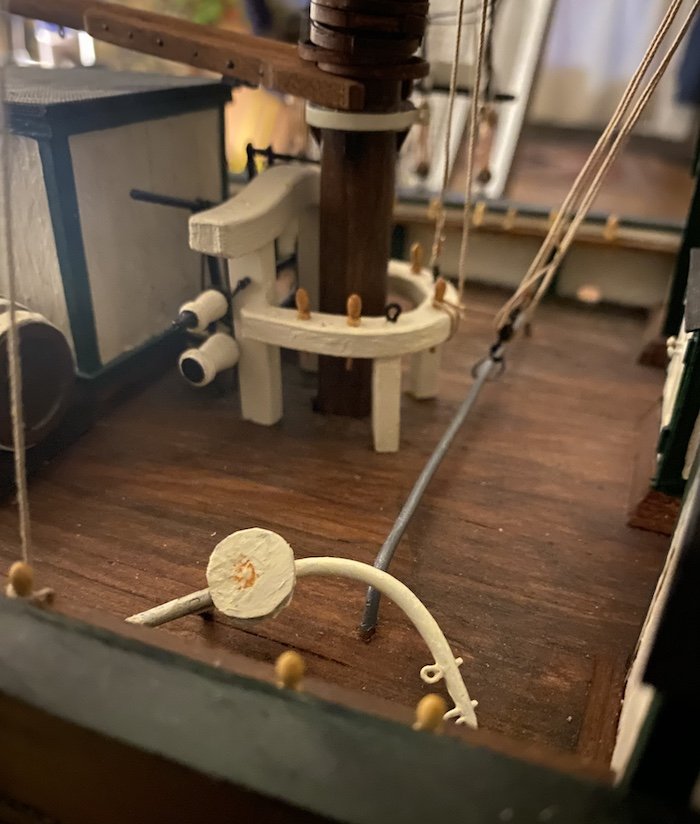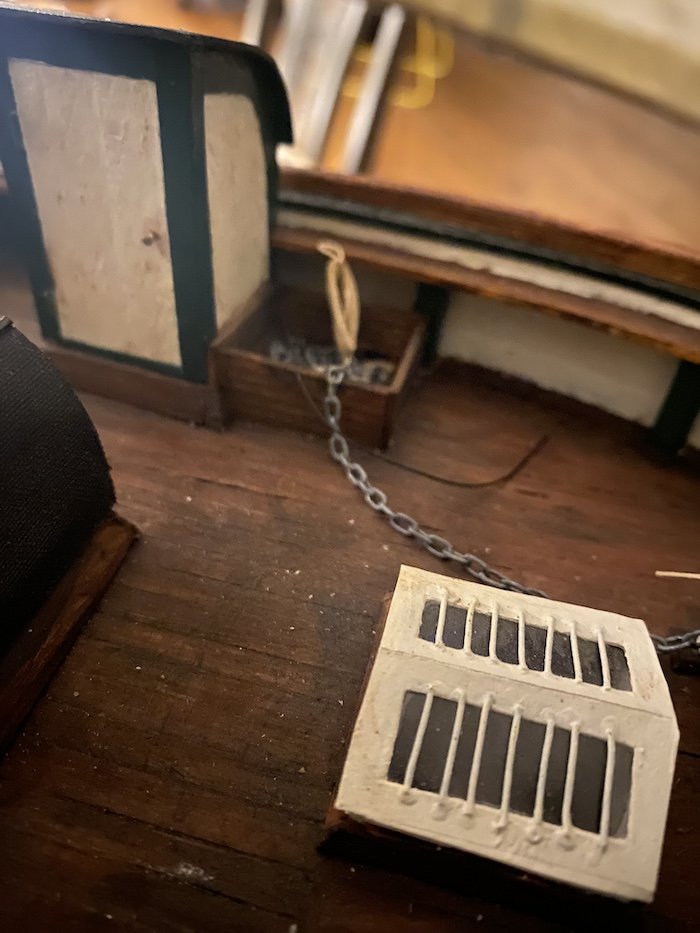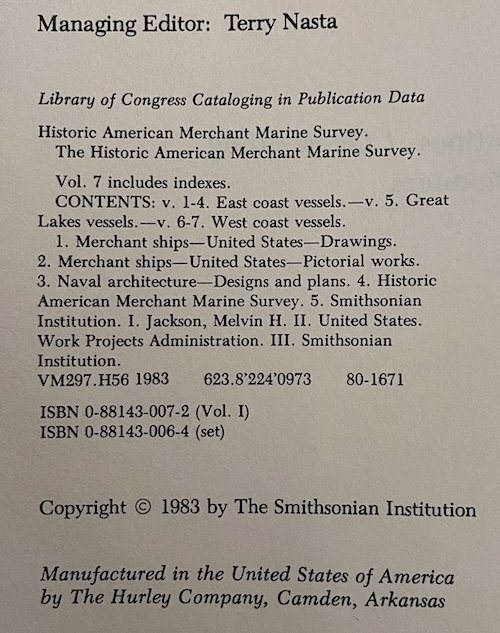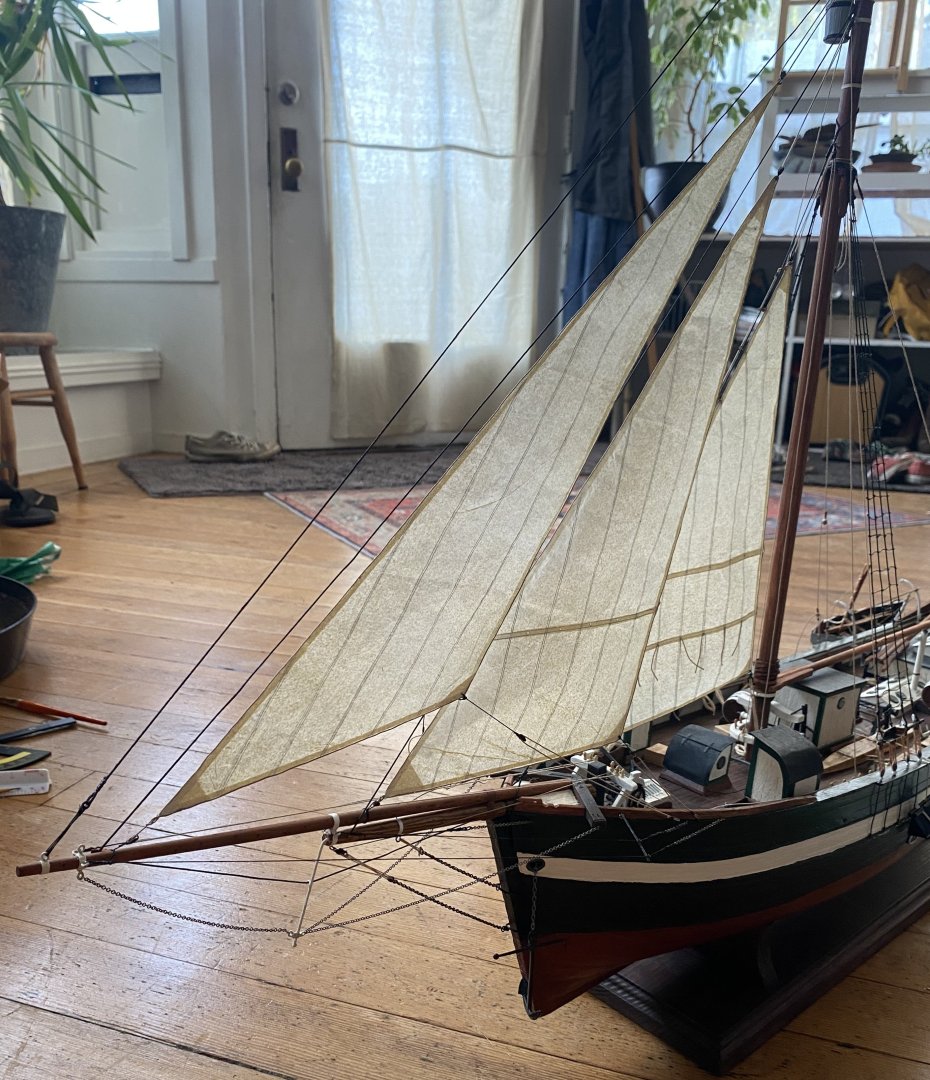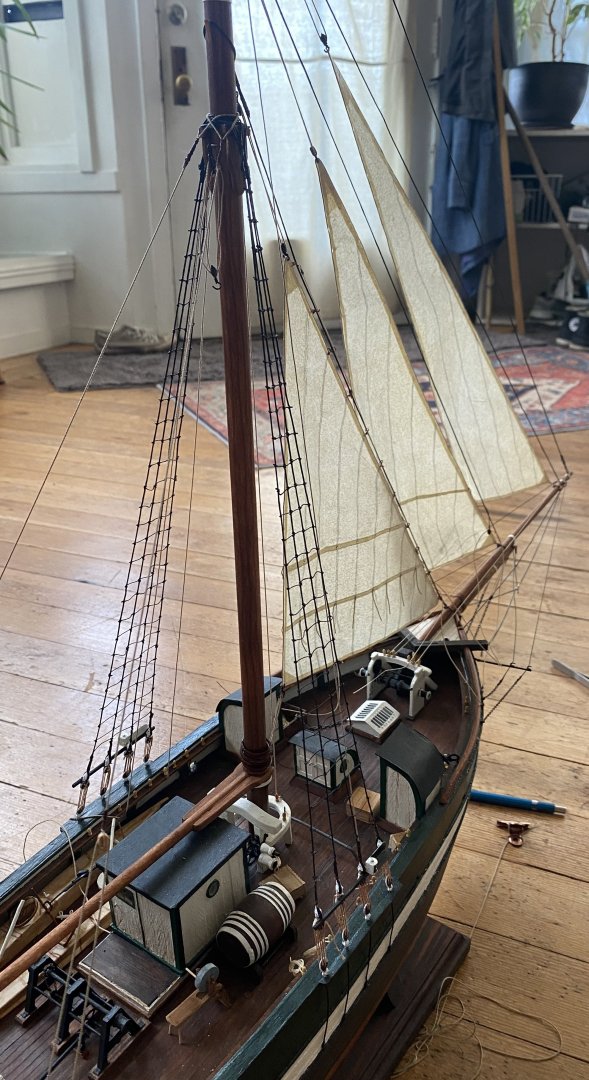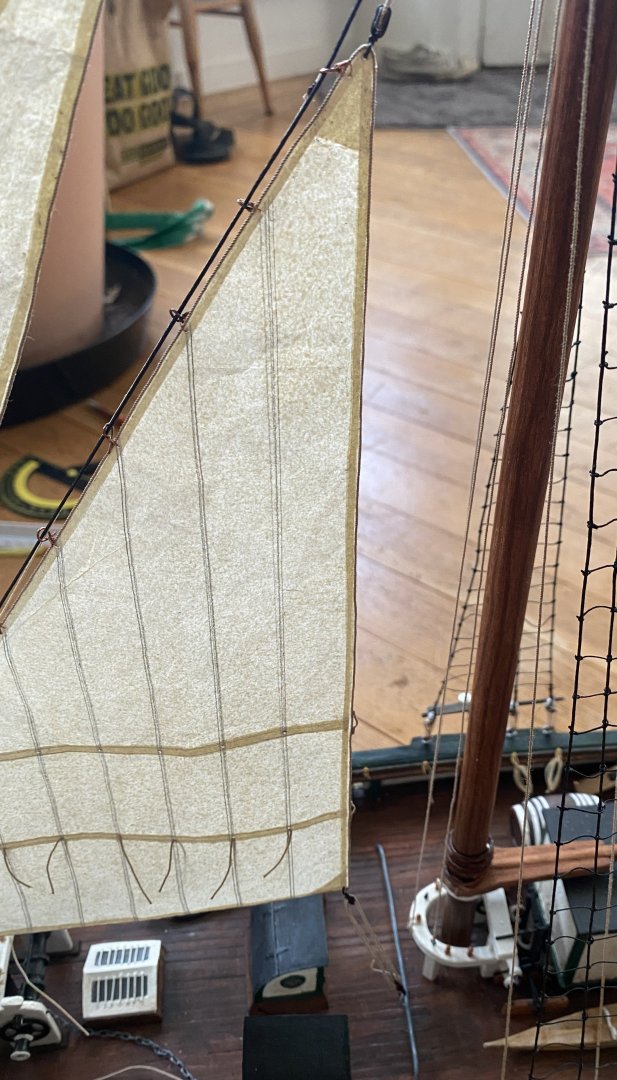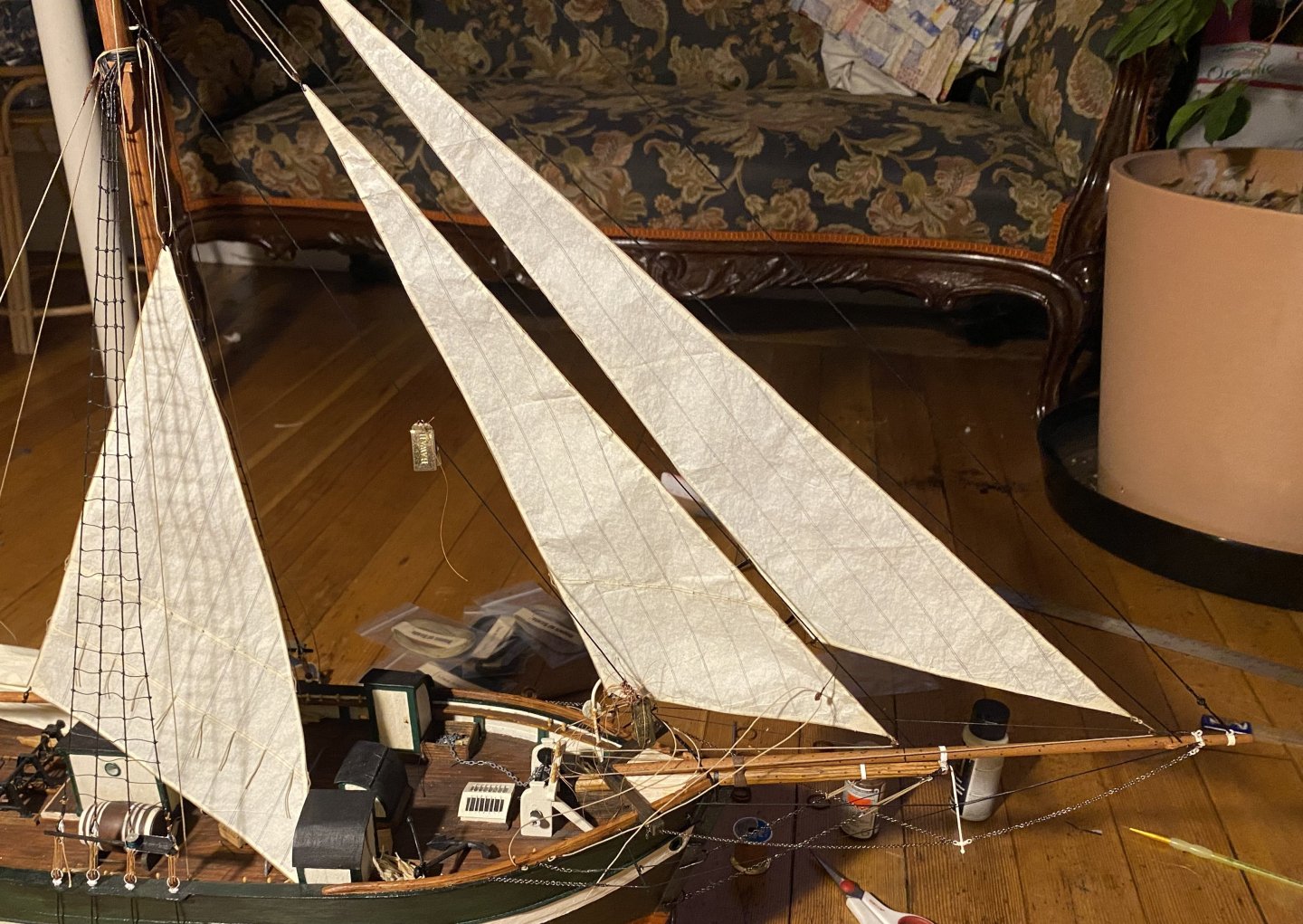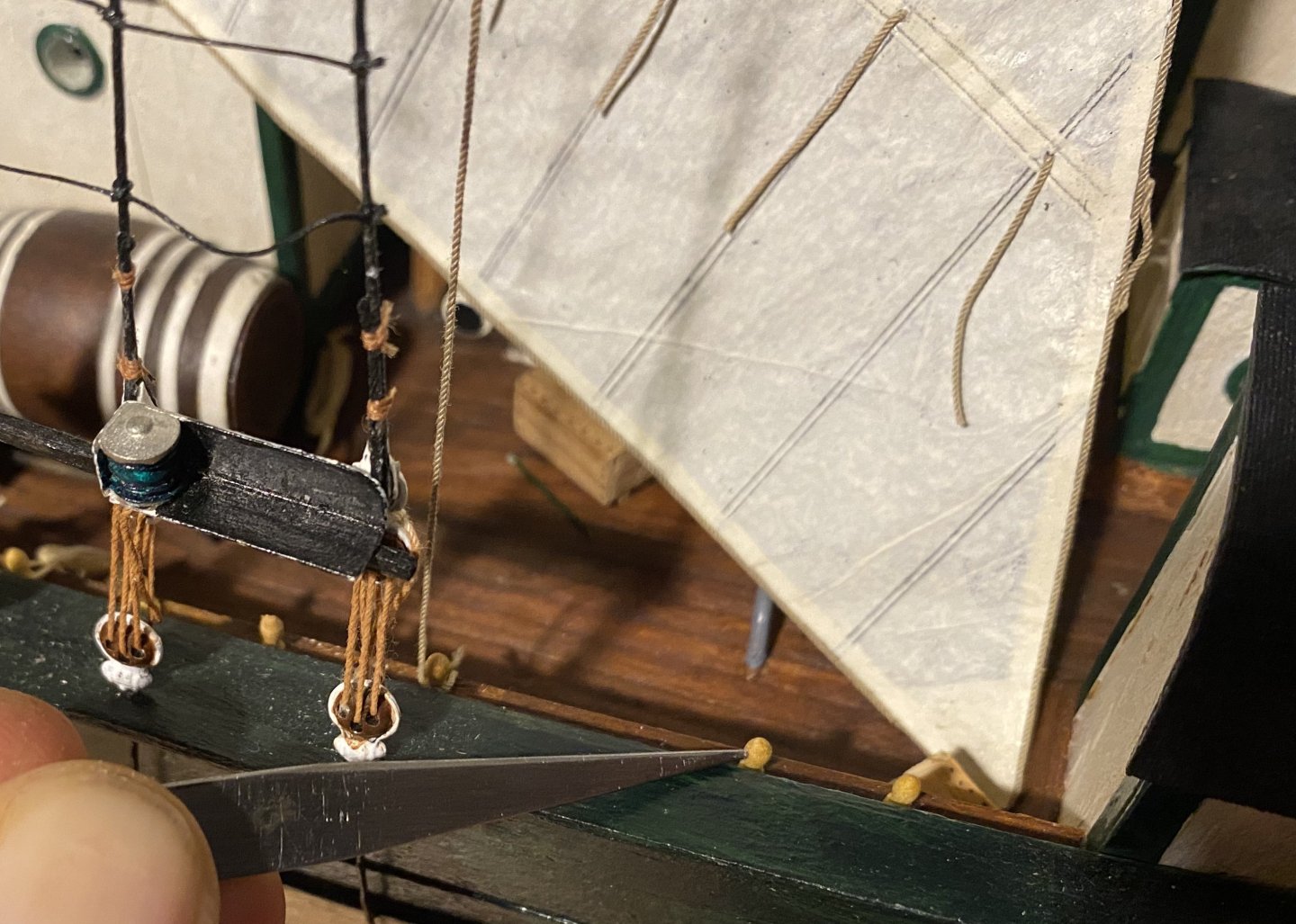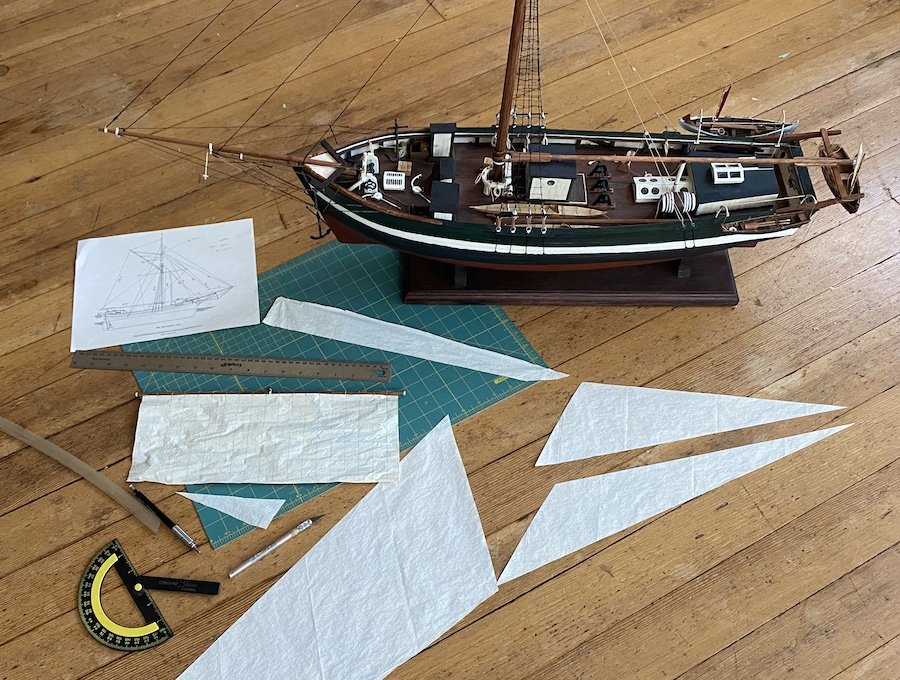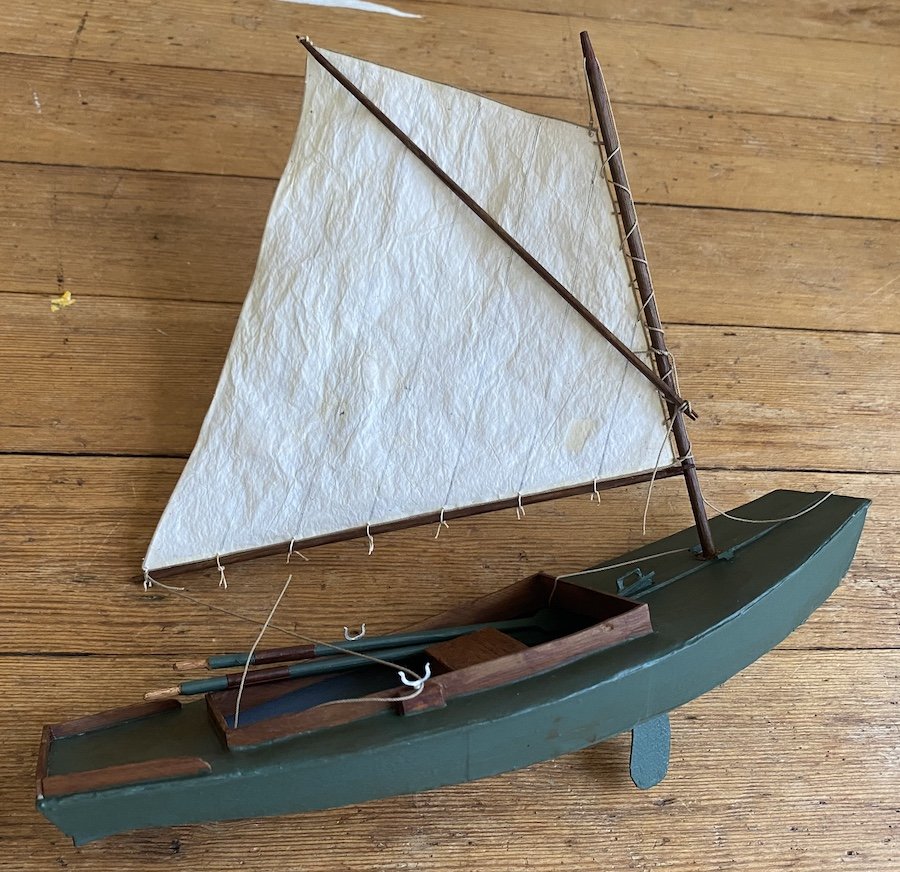-
Posts
457 -
Joined
-
Last visited
Content Type
Profiles
Forums
Gallery
Events
Everything posted by Harvey Golden
-
Almost time to relinquish the dining room table-- I got a lot done though! I'm so pleased with how the sails turned out that I decided to go all out with the rig, so the square, square topsail, and the sprit topsail will be set; Gjøa will be in full bloom by spring! One little hitch discovered this morning. . . I set up the mast's pinrail like how she is in the museum today, but there are apparently a number of pins missing. The old Model Shipways plans shows many more (and their functions), AND I ran out of pins (ordered, though). So, back to the shelf for a while. H-
-
This is great to see! I didn't know about his book on Clinker boats, but am a big fan of his "Working Boats of Britain"-- his pen and ink drawings are about as good as they get (up there with Adkins, Manning, Paris, Af Chapman, etc.). My only (successful) experience with Lapstrake is a finger-size pram for my Gjøa-- I'd like to brush up on it, and it sounds like that's the perfect book and method to use. Will follow along.... Best, H-
-
The mainsail is up! Looking like only minimal adjustments will be needed, mostly just tightening thing up as the boom and gaff hang nicely. Just one hoop glued so far, and just a few robands tied. Peak, Tack, and Clew temporarily fastened and the throat temporarily pinned. Feels nearly done, but a lot more to tend to: matte-ing out glue spots, gluing down falls and attaching hanks to pins, securing both anchors, hanging the rope ladder, tying off the boat lines, adding the main-sheet, and I still have to see about whether or not this ship had a rudder. . . H-
-
No progress worth showing, but some progress made. Lots of adjusting this and that and doing this here and that there . . . and picking up half a dozen loose parral beads from the gaff after they came cascading down from on high (not sure I found them all, but I have several lifetimes' supply). Pretty sure the main gets hung tomorrow, but who knows? Anyhow, I did take some decent photos; all that lack of sanding, using crap wood, and blotchy paint seems to add a bit of je ne sais quoi. H-
-
Thank you Jon! At this stage of building a scratch-built model, one might get the impression I know what I'm doing . . . Rigging in general is beyond my comfort zone, and everything you see is new to me. Along with the knowledge and generosity of others on this forum, the following three things were of great help in executing the rigging: 1. The .pdf "Jakt <Jelse>" https://fartoyvern.no/wp-content/uploads/2022/08/5-21_Jelse_THD_v1_MH-SS.pdf 2. Copies of the old Model Shipways plans for the Gjøa-- particularly the Belaying/sheeting diagram and the details of gaff, boom, yard, etc. 3. Lennarth Petersson's "Rigging: Period Fore-and-Aft Craft." Of the latter reference-- it covers three regional craft, none of which are from Norway, but it illustrates the concepts, purposes, and terminology very clearly, and helps corroborate matters from the other two sources. It's also fascinating to see how different people found differing solutions to the same requirements. FWIW, the British ship in Petersson seems to be the closest to the Gjøa w/r to rigging execution. I hope this is helpful, as is this thread-- I'm very aware there must be mistakes in my project though; I rather wish I was following your path! H-
-
A week-long window of free access to the dining room table has just opened! The model is 40" from tip of the bowsprit to the tender on stern davits-- my "official" model work bench is 41" wide, so this is a rare chance to get some serious work done, with access to both sides. The main goal is to get the main sail on. The last four mast hoops are on-- I did not thread them onto the mast before attaching all the foresail rigging, crow's nest, shrouds, etc., so I cut them open and then glued them back together around the mast. The boom and gaff are already fitted out with blocks, cleats, etc. I also got the parral beads on the gaff and have rigged it into temporary position with the throat halyard and peak halyard. Also, the rope ladder for the crow's nest is ready to hang. Also, I've fitted those puzzling Ørefiken thingies-- shown below, though not rigged-up yet, nor properly attached (will be lashed further). Special thanks again to Steggin, who shared the source that provided the answer of how the Ørefiken was set-up (see .pdf he links to at bottom page 3 here). With luck, I'll be attaching the mainsail tomorrow or so; still have to get the topping lift set up.
-
Not to be left out, I also have a suggestion 😉 I also would hand letter it, but to ensure it has the odd character of the original's lettering and mis-matched weight, etc. I would trace it onto silkspan or tracing paper and then paint the back side (to form the background color). For tracing, I'd get rid of the perspective/foreshortening by simply stretching the image to what looks reasonable-- below is a simple example (it can be printed to proper size, or if you are brave, you can use your computer screen as a "light box"). A Pigma Micron or similar quality pen would make short work of it, even in tiny scale. Just thoughts- H-
-
The Historic American Merchant Marine Survey volumes have a few color plates in them-- rendered artistically by the surveyors. I don't recall which volume, but they show a nice though not extensive range of colors on various parts of certain boats (fishing craft and/or coasters from the 19th C, [though undoubtedly 'touched-up' by the time of the survey] if I recall). Best, H-
-
Hi Jond! Nice to see another scratch built Gjøa on the ways! My 1/32 version is a bit stagnant at the moment, though nearing completion. Yours is looking great, and I envy the slightly smaller scale! Best, Harvey
- 39 replies
-
- Northwest passage
- Norway.
-
(and 2 more)
Tagged with:
-
Thank you Matle! This information is very helpful-- glad you found my build log. The PDF that Steggen linked to (second post from top; this page) is to-date the best info I've come across yet, but you've clearly shown how the line is run to a reef point, which makes sense. Seeing your drawing on the photos makes me think it must have been a way to sheet the foresail with a reef set without lowering the foresail. By keeping the sail raised with a reef in, sheeting to the traveler may not have been a good option physics-wise, so a higher position of the block-- lashed to the stays-- would offer better purchase. This is all just an un-educated theory, though.... Thank you again!
-
Flying Jib, Jib, and Foresail are all up and sheeted. I used Dr PR's method of making the hanks on the foresail, as noted on his build-log of the Albatross-- thanks Phil! The Øerifiken continues to perplex, particularly with regards to its purpose, and is so far omitted. I've got a book en-route that will hopefully help. The sheeting of the foresail on the traveler is made exactly like that in the paper Steggin linked to on the previous page-- one with a cleat mounted right on the side of the lower block. The foresail also has a downhaul rigged with a light line. The falls are mostly glued to the proper pins-- will be adding separate rope coils soon. Here are some pics: The model's keel is 1-1/2" above the floor (on the stand), and the mast tops out at over 36" high-- my usual work-space is too small for this model, so I've moved it to the living room floor (I live in a 1913 corner grocery store, so a very spacious living room with 11' ceilings). I've been working on the rigging for the gaff and boom, attaching anchor points for blocks on mast, boom, and gaff. More line and more blocks have been ordered. . . going through this stuff fast! H--
-
Thanks Siggi! I used archival pva glue to attach the bolt ropes. Just a line of glue along the sail edge, then push the rope against it; once it is situated properly, I elevate the glued section to dry (ensuring it doesn't adhere to the table). I just do about 4-5 inches at a time. Hope this helps! H-
-
I just saw your build of the St. Roch-- that is a lovely model!!! I've been aboard at the VMM some years back, and it is good to see it preserved. First, I know very little about handling ships like these, but the idea of a fixed cleat for a sheet connected to the traveler seems like it would restrict the movement. I had been thinking maybe it was cleated to a cleat affixed to one of the lines adjacent the blocks, or something like that-- figure 117 in the paper Steggen linked to shows a variation of this, where the cleat is affixed directly to a block. Now I'm wondering what the cleat is for on the St. Roch (also wondering how wrong I am about all of this 😉). Thank you again! H-
-
The Flying Jib and Jib are up! The panel lines pattern is modeled after that shown on the 1950 Model Shipways plans . . . I hope they're correct, as I've also seen them represented bisected/joined at the clew, perpendicular to the luff (forgive the poor description...). I can't recall seeing photos of the Gjøa with her rig up, at least not ones clear enough to see the panel lines. Two historic paintings (by Fredrik Sørvig) of the Gjøa do show panel lines like on the MS plans, though the paintings were done well before Amundsen bought it in 1901 (The paintings are reproduced in Amundsen's Diaries, 2017; Fram Museum). Here she is: As you can see, the foresail is also in progress. While I have copies of the 1950 plans, I do not have instructions and there is a term on the sheeting/pin-rail plans that I am not familiar with, and can't seem to turn it up anywhere: "Ørefiken." The term on the plans is keyed to belaying pins on port and starboard, just behind the pins marked for the Squaresail Tack; the starboard pin related to the mystery term is shown below. Any ideas, or better yet, a definition? Another question I am struggling with is in regards to how the foresail is sheeted to the traveler. I'm inferring that a double block with an end ring is hooked to the clew, and the line runs through a single(?) block hooked to a ring on the traveler, but where does the fall go? Any help will be most welcome! In other news, I've learned (for next time) to put mast hoops on before the trucks, stays, crow's nest, and shrouds are in place 😉 H-
-
Hello all! Am still at it despite being busy with many other projects. It has taken a while to wrap my head around the silksspan-for-sails on what is a very large model. I started with the Gjöa's square sail, which will be furled; it's visible in the photo, un-furled and not cut full-size. I need to brush up on how to properly furl a squaresail; I must have been sick the day they covered it in middle school. I've painted up enough paper for the Gjöa's sails, using a roller as-per Tom Lauria on youtube. The jib and flying jib are cut so far. A good way (for me) to get a hang of these sails was to re-rig old models I had laying about. Here is a Garvey from Barnegat Bay, N.J. built from Chapelle's drawing in "American Small Sailing Craft" (modified slightly to represent a full-size version I built). I chucked the old cloth sail and put this one on: It's got separate edge pieces glued on, penciled panel lines, roped edging, and a few patches here and there for good measure. Practice makes passable . . . hopefully!
-
The chain drive on Gjøa thread is here, mostly on page 2: https://modelshipworld.com/topic/34394-gjøa-1872-by-harvey-golden-roald-amundsens-cutter-built-at-rosedahl-norway/page/2/#comments (thanks to all that helped with that puzzle).
About us
Modelshipworld - Advancing Ship Modeling through Research
SSL Secured
Your security is important for us so this Website is SSL-Secured
NRG Mailing Address
Nautical Research Guild
237 South Lincoln Street
Westmont IL, 60559-1917
Model Ship World ® and the MSW logo are Registered Trademarks, and belong to the Nautical Research Guild (United States Patent and Trademark Office: No. 6,929,264 & No. 6,929,274, registered Dec. 20, 2022)
Helpful Links
About the NRG
If you enjoy building ship models that are historically accurate as well as beautiful, then The Nautical Research Guild (NRG) is just right for you.
The Guild is a non-profit educational organization whose mission is to “Advance Ship Modeling Through Research”. We provide support to our members in their efforts to raise the quality of their model ships.
The Nautical Research Guild has published our world-renowned quarterly magazine, The Nautical Research Journal, since 1955. The pages of the Journal are full of articles by accomplished ship modelers who show you how they create those exquisite details on their models, and by maritime historians who show you the correct details to build. The Journal is available in both print and digital editions. Go to the NRG web site (www.thenrg.org) to download a complimentary digital copy of the Journal. The NRG also publishes plan sets, books and compilations of back issues of the Journal and the former Ships in Scale and Model Ship Builder magazines.


